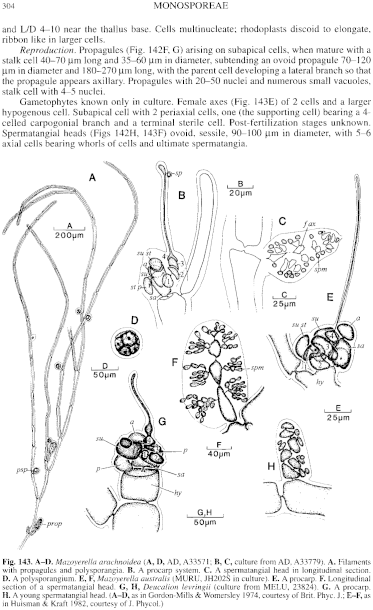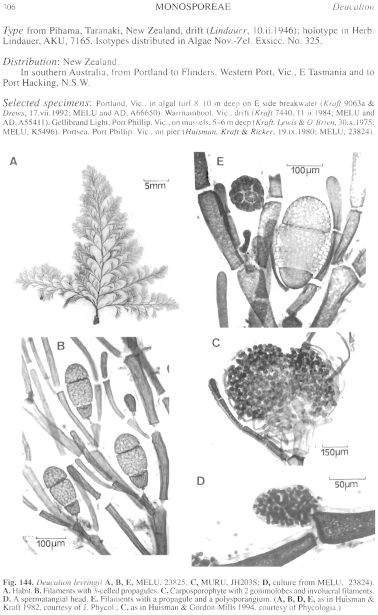|
|
|
|
|
|||||||||||
|
Electronic Flora of South Australia Species Fact Sheet
Phylum Rhodophyta – Order Ceramiales – Family Ceramiaceae – Tribe Monosporeae
Selected citations: Huisman & Gordon-Mills 1994: 87, figs 8, 24, 25. Lewis 1983: 262. Millar & Kraft 1993: 39.
Synonym
Callithamnion levringii Lindauer 1949: 350.
Thallus (Fig. 144A) erect, red-brown, 4–10 cm high, complanately branched with alternately distichous laterals for 2 orders, the third order laterals largely adaxially branched. Attachment by the basal cell and rhizoids from the 3–4 lowest cells of the main axes; epilithic or on mussels. Structure. Apical cells 35–55 µm in diameter and L/D (1–) 2–4, dividing transversely, increasing to median cells 160–220 µm in diameter and L/D 1.5–2.5 and 250–380 µm in diameter and L/D (1–) 4–6 in lower cells. Cells multinucleate; rhodoplasts discoid to elongate, ribbon like in larger cells.
Reproduction: Propagules (Fig. 144B, E) 3-celled, ovoid, with the central cell larger than the apical and basal cells, 100–150 µm in diameter and 200–280 µm long, borne on a short (L/D 1.5–2) stalk cell in branch axils.
Gametophytes dioecious. Procarps (Fig. 143G) on subterminal cells of a 2 or 3-celled axis, with 3 periaxial cells, one being a supporting cell with a 4-celled carpogonial branch and a terminal sterile cell. Post-fertilization an outer involucre of branched filaments arises from the hypogenous and subhypogenous cells. Carposporophytes (Fig. 144C) of 2 gonimolobes from 2 auxiliary cells. Spermatangial heads (Figs 143H, 144D) in adaxial series on lateral branches, sessile, elongate, with axes 5 cells long, cutting off spermatangia directly or via initials.
Polysporangia (Fig. 144E) on upper ends of lower cells of branchlets, sessile, subspherical, 80–100 in diameter, with 24–36 spores.
Type from Pihama, Taranaki, New Zealand, drift (Lindauer, 10.ii.1946); holotype in Herb. Lindauer, AKU, 7165. Isotypes distributed in Algae Nov.-Zel. Exsicc. No. 325.
Selected specimens: Portland, Vic., in algal turf 8–10 m deep on E side breakwater (Kraft 9063a & Drews, 17.vii.1992; MELU and AD, A66650). Warrnambool, Vic., drift (Kraft 7440, 11.ii.1984; MELD and AD, A55411). Gellibrand Light, Port Phillip, Vic., on mussels, 5–6 m deep (Kraft, Lewis & O'Brien, 30.x.1975; MELD, K5496). Portsea, Port Phillip, Vic., on pier (Huisman, Kraft & Ricker, 19.ix.1980; MELU, 23824).
Distribution: New Zealand.
In southern Australia, from Portland to Flinders, Western Port, Vic., E Tasmania and to Port Hacking, N.S.W.
Taxonomic notes: Flinders, Western Port, Vic., on pier (Huisman & Gabrielson, 3.ix.1981; MELU, 24019). Bicheno, Tas., in bryozoan turf, 20–22 m deep (Kraft 9393, 18.xii.1992; MELU and AD, A66649). Arch Rock, Ninepin Point, Tas., 1–10 m deep (Andrews, 21.x.1994; AD, A63905). Port Hacking, N.S.W., in turf to 23 m deep (Watson, Sept. 1976; MELU).
Deucalion levringii was considered by Huisman & Kraft (1982, p. 179) to be a recent adventive from New Zealand.
References:
HUISMAN, J.M. & GORDON-MILLS, E.M. (1994). A proposal to resurrect the tribe Monosporeae Schmitz et Hauptfleisch, with a description of Tanakaella itonoi sp. nov. (Ceramiaceae, Rhodophyta) from southern and western Australia. Phycologia 33, 81–90.
HUISMAN, J.M. & KRAFT, G.T. (1982). Deucalion gen. nov. and Anisoschizus gen. nov. (Ceramiaceae, Ceramiales), two new propagule-forming red algae from southern Australia. .1. Phycol.18, 177–192.
LEWIS, J.A. (1983). Floristic composition and periodicity of subtidal algae on an artificial structure in Port Phillip Bay (Victoria, Australia). Aquatic Bot. 15, 257–274.
LINDAUER, V.W. (1949). Notes on marine algae of New Zealand. I. Pacif. Sci. 3, 340–352.
MILLAR, A.J.K. & KRAFT, G.T. (1993). Catalogue of marine and freshwater Red Algae (Rhodophyta) of New South Wales, including Lord Howe Island, South-western Pacific. Aust. Syst. Bot. 6, 1–90.
The Marine Benthic Flora of Southern Australia Part IIIC complete list of references.
Publication:
Womersley, H.B.S. (24 December, 1998)
The Marine Benthic Flora of Southern Australia
Rhodophyta. Part IIIC. Ceramiales – Ceramiaceae, Dasyaceae
©State Herbarium of South Australia, Government of South Australia
Illustrations in Womersley Part IIIA, 1998: FIGS 143G, H, 144.

Figure 143 enlarge
Fig. 143. A–D. Mazoyerella arachnoidea (A, D, AD, A33571; B, C, culture from AD, A33779). A. Filaments with propagules and polysporangia. B. A procarp system. C. A spermatangial head in longitudinal section. D. A polysporangium. E, F, Mazoyerella australis (MURU, JH2O2S in culture). E. A procarp. F. Longitudinal section of a spermatangial head. G, H, Deucalion levringii (culture from MELU, 23824). G. A procarp. H. A young spermatangial head. (A–D, as in Gordon-Mills & Womersley 1974, courtesy of Brit. Phyc. J.; E–F, as in Huisman & Kraft 1982, courtesy of J. Phycol.)

Figure 144 enlarge
Fig. 144. Deucalion levringii A, B, E, MELU, 23825; C, MURU, JH2O3S; D, culture from MELD, 23824). A. Habit. B. Filaments with 3-celled propagules. C. Carposporophyte with 2 gonimolobes and involucral filaments. D. A spermatangial head. E. Filaments with a propagule and a polysporangium. (A, B, D, E, as in Huisman & Kraft 1982, courtesy of J. Phycol.; C, as in Huisman & Gordon-Mills 1994, courtesy of Phycologia.)

|
Email Contact: State Herbarium of South Australia |

|